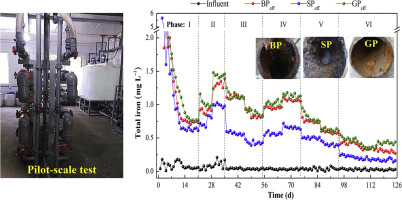当前位置:
X-MOL 学术
›
Water Res.
›
论文详情
Our official English website, www.x-mol.net, welcomes your
feedback! (Note: you will need to create a separate account there.)
Impacts of water quality on the corrosion of cast iron pipes for water distribution and proposed source water switching strategy
Water Research ( IF 11.4 ) Pub Date : 2017-10-31 , DOI: 10.1016/j.watres.2017.10.065 Jun Hu , Huiyu Dong , Qiang Xu , Wencui Ling , Jiuhui Qu , Zhimin Qiang
Water Research ( IF 11.4 ) Pub Date : 2017-10-31 , DOI: 10.1016/j.watres.2017.10.065 Jun Hu , Huiyu Dong , Qiang Xu , Wencui Ling , Jiuhui Qu , Zhimin Qiang

|
The switch of source water may induce “red water” episodes. This study investigated the impacts of water quality on the corrosion of cast iron pipes for water distribution at a pilot scale and proposed source water switching strategy. Three sets of old cast iron pipe section named BP, SP and GP were excavated, transporting blend water, surface water and groundwater, respectively. The increase of chloride and sulfate concentration accelerated iron release, while the effects of alkalinity and hardness exhibited an opposite tendency. The shift from free chlorine to monochloramine slightly inhibited iron release, while the impact of peroxymonosulfate depended on the source water pipe historically transported. The dissolved oxygen consumption is highly consistent with the iron release in the three pipes. The mass ratio of magnetite to goethite of the corrosion scales in SP was higher than those in BP and GP and almost kept unchanged during the operation period. The formation of siderite and calcite confirmed the increase of alkalinity and calcium hardness was beneficial to control iron release. The increased content of Cl, S and Ca further verified the impacts of water quality on the composition of corrosion scales. Bacterial community analysis indicates that iron-reducing bacteria decreased in BP and increased in SP and GP, while sulfur-oxidizing bacteria, sulfate-reducing bacteria and iron oxidizing bacteria increased in BP, SP and GP. To avoid the occurrence of “red water” episodes during the reverse switch process, the blending ratio should be less than 0.15.
中文翻译:

水质对配水铸铁管腐蚀的影响及拟议的水源切换策略
水源的切换可能导致“红水”事件。本研究以中试规模研究了水质对配水用铸铁管腐蚀的影响,并提出了源水转换策略。开挖了三套分别为BP,SP和GP的旧铸铁管段,分别输送混合水,地表水和地下水。氯化物和硫酸盐浓度的增加促进了铁的释放,而碱度和硬度的影响则呈现相反的趋势。从游离氯到一氯胺的转移略微抑制了铁的释放,而过氧一硫酸盐的影响取决于历史上运输的水源水管。溶解氧的消耗与三个管道中的铁释放高度一致。SP中腐蚀垢的磁铁矿与针铁矿的质量比高于BP和GP的,并且在运行期间几乎保持不变。菱铁矿和方解石的形成证实了碱度的增加和钙硬度的增加有利于控制铁的释放。Cl,S和Ca含量的增加进一步验证了水质对腐蚀水垢成分的影响。细菌群落分析表明,BP,SP和GP中,铁的还原菌在BP中减少,在SP和GP中增加,而硫氧化菌,硫酸盐在还原菌和铁氧化细菌在BP,SP和GP中增加。为避免在反向切换过程中出现“红水”事件,混合比例应小于0.15。
更新日期:2017-10-31
中文翻译:

水质对配水铸铁管腐蚀的影响及拟议的水源切换策略
水源的切换可能导致“红水”事件。本研究以中试规模研究了水质对配水用铸铁管腐蚀的影响,并提出了源水转换策略。开挖了三套分别为BP,SP和GP的旧铸铁管段,分别输送混合水,地表水和地下水。氯化物和硫酸盐浓度的增加促进了铁的释放,而碱度和硬度的影响则呈现相反的趋势。从游离氯到一氯胺的转移略微抑制了铁的释放,而过氧一硫酸盐的影响取决于历史上运输的水源水管。溶解氧的消耗与三个管道中的铁释放高度一致。SP中腐蚀垢的磁铁矿与针铁矿的质量比高于BP和GP的,并且在运行期间几乎保持不变。菱铁矿和方解石的形成证实了碱度的增加和钙硬度的增加有利于控制铁的释放。Cl,S和Ca含量的增加进一步验证了水质对腐蚀水垢成分的影响。细菌群落分析表明,BP,SP和GP中,铁的还原菌在BP中减少,在SP和GP中增加,而硫氧化菌,硫酸盐在还原菌和铁氧化细菌在BP,SP和GP中增加。为避免在反向切换过程中出现“红水”事件,混合比例应小于0.15。











































 京公网安备 11010802027423号
京公网安备 11010802027423号